Other Models:
 1976-1981
1976-1981
In 1976, the Accord joined the successful but diminutive Civic and was an instant success. The Accord offered more room, style and power while still being economical and reliable.
Initially available only in two-door hatchback form, the Accord rode a 93.7-inch wheelbase, weighed about 2,000 pounds. The Accord's standard equipment list included features such as AM/FM stereo radio, rear defroster/wiper/washer and remote hatch release.
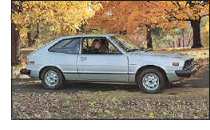
The Accord's 1.6-liter four-cylinder engine had an output of 68 horsepower. A unique feature of the Accord's engine was Honda's CVCC head design that promoted cleaner, more efficient combustion which did not require a catalytic converter nor unleaded fuel to meet emissions standards. Transmission choice consisted of the standard, slick-shifting five-speed manual gearbox or a two-speed "Hondamatic" that blunted any attempts at peppy performance.
There were no changes in the Accord's sophomore year, 1977.
An LX version debuted in 1978 and had standard luxury items such as velour upholstery, air conditioning and a digital clock. Accord's sales rose from 18,643 in 1976 to over 120,000 for 1978.
1979 saw the the addition of a four-door sedan, which only in one trim level. The engine grew in size to nearly 1.8 liters and output went up to 72 horsepower. Other improvements included the addition of an oil cooler, power steering and a tachometer to the standard features list, a larger radiator and more efficient exhaust system.
Other than the optional automatic transmission having three speeds instead of the former two, and minor cosmetic upgrades, not much else changed for 1980.
In 1981, the SE luxury trim level was offered. The SE stocked an Accord Sedan with leather seating, power windows and door locks, alloy wheels and a sound system with cassette deck.
As far as pricing went, a 1976 Accord was $3,995. By 1980 the base hatchback's price had gone up 50 percent, to $5,949, and the LX version was $1,000 more. The 1980 Accord Sedan was $6,515.
1982-1985
Honda revamped the Accord for 1982 with increases in the wheelbase (by about 3 inches) and length (by less than 2 inches) providing more room for rear passengers. With mechanical components carried over from 1981, the Accord was basically unchanged aside from a slight increase in horsepower for the 1.8-liter engine from 72 to 75 hp. Pricing for the '82 Accords was $7,399 for the base two-door hatchback, $8,245 for the four-door sedan and $8,449 for the LX version of the two-door.
1982 also saw the start of Accord production in the U.S at the Marysville, Ohio plant.
1983 brought one major improvement; a four-speed automatic replaced the three-speed unit. Other than that, the 1983 Accords were similar to the 1982s.
Found under the hood of the freshened 1984 Accord was a new 1.8-liter engine good for 11 more horsepower over the '83 models, for a total of 86 ponies. Honda did away with the CVCC head design, as more stringent emissions standards required a new approach and the use of a catalytic converter. The body's facelift included a new grille and headlights along with smoother, more integrated bumpers. The two-door models also received suspension revisions that imparted sportier handling. An LX Sedan was added to the lineup, fully equipped with A/C, power windows and door locks, and a four-speaker stereo with cassette deck.
1985 was the last year for the second-generation Accord, and as before, Honda offered a special version of the four-door to celebrate called the "SE-i," the small "i" indicating that the engine's induction was by fuel injection, as opposed to the other Accords, which had a carburetor. A healthy increase of 24 horsepower added a bit of sizzle to the decked-out SE-i, which also had exclusive alloy wheels, bronze-tinted glass and leather seating added to the LX's already substantial standard features.
1986-1989
Accord for 1986 saw an increase of nearly 6 inches in the wheelbase and 3 inches in overall length. Weight for an LX Sedan increased nearly 200 pounds; from 2,341 lbs. for a 1985 to 2,529 lbs. for the new 1986. The new Accord also had a much sleeker look, with pop-up headlights and much better aerodynamics. Sedans came in base DX, luxury LX and loaded LXi trim levels. The two-door hatchback came in either DX or LXi guise. The LXi included all the features of the LX (such as air conditioning and power everything) and added fuel injection, alloy wheels and, on the sedan, a power moonroof.
To handle the bigger, heavier Accords, the engine was increased in size, from 1.8 to 2.0- liters and produced either 98 horsepower (in the carbureted DX and LX trims) or 110 ponies in the fuel-injected LXi. An all-new suspension featured "double-wishbone" design at all four wheels.
Pricing for the 1986 Accords ranged from $8,429 for a DX Hatchback Coupe to $12,675 for the LXi Sedan.
1987 saw no changes to the wildly popular Accord.
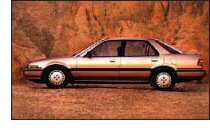
An Accord Coupe joined the hatchback and sedan for 1988. As with the hatchback, the new notchback two-door was available in either base DX or loaded LXi trim. Very minor tweaks to the sedan's taillights and bumpers were the lone visual changes for the '88 Accord. Functionally, a bump in horsepower for the LXi engine (from 110 to 120 hp) improved the performance of the top Accords.
In accord with Accord tradition, Honda brought out an SE-i version of the Accord to mark the last year of a generation, in this case 1989. Chock-a-block with luxury features, some highlights of this special Accord included plush leather seats, a high-performance Bose stereo/cassette sound system and remote stereo controls located on the steering wheel. Also setting the SE-i apart from ordinary Accords were 14-inch alloy wheels, four-wheel disc brakes and bronze-tinted glass. The other Accords were unchanged for 1989.
1990-1993
The 1990 Accord was completely revamped, inside and out. The hatchback was dropped, leaving a notchback coupe and a four-door sedan as available choices. Wheelbase was increased by nearly 5 inches (now 107.1 inches), and weight went up, though even the heaviest Accord, the EX four-door, still weighed less than 3000 pounds. Styling in and out was very clean and purposeful, with a low beltline, large greenhouse (window area) and slim roof pillars that minimized blind spots. The uncluttered and chiseled appearance of the '90 Accord gave an overall impression of quality and solidity.
In keeping with Honda's logical system of offering a few versions of each car with increasing standard features three trim levels were available. One could choose a basic DX, a well-equipped LX (which, as before, had power windows/locks/mirrors, cruise control, A/C and a decent stereo cassette all standard) or the top-shelf EX (which added a power moonroof, alloy wheels and 5 more horsepower to an LX).
On the mechanical side, fuel injection was made standard on all Accords. The new 2.2-liter engine pumped out 125 horsepower in DX and LX trims, and 130 horses in the EX. Other changes included electronic control for the automatic transmission and motorized front shoulder belts.
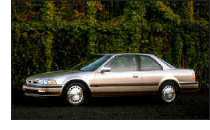
1990 Accords ranged in price from $12,145 for the DX Coupe to $16,595 for an EX Sedan.
Honda finally catered to those who loved the Accord but needed more luggage space by bringing out an Accord Wagon for 1991, which could be had in LX or EX trim levels. The wagon provided a total cargo volume (with the second seat flipped down) of nearly 65 cubic feet. And even with that seat up, there was still nearly 35 cubic feet available -- more than double the capacity of the sedan's trunk. Curiously, driver's side airbags were fitted to the wagons (which as a result did not need to use the motorized front shoulder belts) but not the sedans. And in a break with tradition, Honda brought out an SE (the "i" was dropped because all Accords were now injected) version, even though this was not the last year for this iteration of the Accord. The SE gilded the lily with leather seats, a more powerful engine (140 horsepower against the EX's 130) and antilock brakes, which were a first for the Accord. Capping the changes for this year was the addition of color-keyed mirrors on the LX and EX.
Feeling more generous, Honda equipped all 1992 Accords with a driver's side airbag, eliminating the somewhat annoying motorized shoulder belts of the sedans. This year, the SE was dropped from the team and the EX benefited by getting the 140 horsepower motor and four-wheel disc brakes with ABS (antilock braking system) formerly fitted to the SE. Revisions to the grille and bumpers were so subtle as to be barely noticeable. A more obvious update was fashioned on the taillights (except on the wagon), which made it easier to tell a '92 Accord Coupe or Sedan from its '91 counterpart.
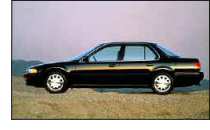
Returning to business as usual, Honda brought back the SE for the fourth generation's last year, 1993. In addition to the expected leather seating and Bose stereo, the '93 SE was also available as a coupe version and (inexplicably) the sedan but not the coupe received a passenger's side airbag. A 10th anniversary LX Sedan model shared some features with the upper-end Accords, such as the dual airbags, alloy wheels and ABS.
1994-1997
The 1994 Accord was improved over the '93 in many ways; more power for all engines, a refined automatic transmission, increased safety by way of standard dual front airbags on all versions and the compliance with 1997 side-impact crash standards three years early. A quieter ride and improved handling were benefits of a stiffer structure and a more aerodynamic body. But the new body, with its flared-out hindquarters and high tail, didn't win approval from some who felt it looked somewhat chunky (especially from a rear three-quarter viewpoint) when compared to the lean '90 to '93 era Accord. Along with the new body, DX versions gained color-keyed bumpers (in place of the former dark gray ones) and a right-hand side view mirror.
The '94 engines were upgraded, with each version receiving a 5 horsepower bump in output, meaning 130 horses now motivated the DX and LX models and EXs boasted 145 ponies. More importantly, the EX's engine featured Honda's "VTEC" (Variable valve Timing and lift, Electronic Control) system. VTEC promoted more efficient "breathing" at all engine speeds, meaning there was plenty of power available at low rpm, as well as a satisfying rush as the tach needle sped toward redline. A new "Grade Logic" electronic control system for the automatic transmission prevented the gearbox from "hunting" (the annoying tendency for some automatics to cycle back and forth between two gears while ascending a hill) and instead would keep the car in the lower gear until the grade leveled off. While going down a steep hill, this tranny would downshift (as opposed to remaining in a higher gear) to allow engine braking to assist in keeping the car's speed in check. And for '94, the DX and LX could be equipped with ABS, as it was made optional for those models.
Pricing for the 1994 Accord ranged from $14,130 for the DX two-door to $21,550 for an EX four-door with leather interior.
1995 saw the arrival of the first V6 engine in an Accord. Available in the LX or EX Sedans, this was actually an old engine, the same 2.7-liter used in the pre-1991 Acura Legend. Rated at 170 horsepower and matched only to a four-speed automatic transmission, the V6 was about one second quicker to 60 mph (at around 8.5 seconds) versus the four-cylinder car. It was also quieter and smoother than the four banger, itself an engine known for refinement. To accommodate the bulkier motor, V6 Accords had a slightly longer nose, and to add an upscale touch, the grille was trimmed in chrome. The EX V6 also had leather seating standard, and other EX news included the discontinuance of the manual transmission EX Wagon.
Styling was tweaked slightly and standard features were beefed up for the 1996 Accord, the third year of this generation. The facade for four-cylinder models was given the same upscale, chrome-trimmed grille as the V6 models, the tail of the car received larger taillight clusters, and bumpers were revised.
Radio antennas (and possible car wash mishaps) were eliminated on LX and EX models via the placement of the antenna in the rear window. Other upgrades included the fitment of a roof rack to EX Wagons, restyled wheels, a trunk pass-through feature added for LX and EX Coupes and Sedans, and a power driver's seat for V6 versions of the LX and EX.
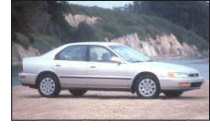
Aside from a "Special Edition" sedan that was basically an LX with a few upscale features added, such as a moonroof and a CD deck, the 1997 Accord was otherwise unchanged for the last year of the fifth generation.
Current Generation
More, more, more. Honda's flagship got bigger and better for 1998. The new body style is something of a return to the sleeker, slim pillar and lean flank style Honda used prior to the somewhat chubby '94 to '97 generation. A 7-cubic-foot increase in interior room moves the Accord sedan up to midsize status from its former compact standing.
More power is on tap, too. The 2.3-liter inline four in LX and EX models uses Honda's VTEC system and makes 150 horsepower. The DX doesn't have the high-tech variable valve timing system and is rated at 135 ponies. A new 3.0-liter V6 produces 200 horsepower (30 more than the V6 that was available in 1997) and can be had in LX and EX models.
The station wagon was dropped, leaving sedans in DX, LX and EX trim levels and coupes in LX and EX guise.

